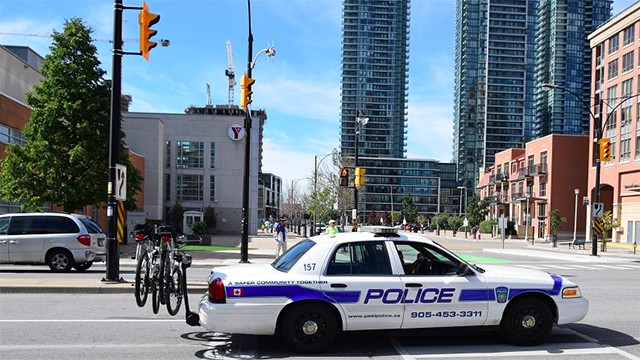Brampton and Mississauga set to battle over police funding
Published December 13, 2019 at 8:22 pm

A battle is brewing between Brampton and Mississauga over how to appropriately fund Peel Regional Police, the police service that serves both cities.
At a tense Dec. 12 Region of Peel council meeting, the day ended on an awkward note when Brampton councillors walked out and refused to vote on a motion to explore the idea of changing how the substantial police service is funded by the two cities.
The City of Mississauga, which has been trying to extricate itself from the Region of Peel, was dealt a huge blow when the province elected to keep all of Ontario’s regional governments intact. After the news broke, Mississauga pledged to continue to advocate for independence and promised to seek a more equitable division of expenses at the regional level in the meantime.
One area Mississauga claims it’s overspending compared to Brampton?
Policing.
In November, Mississauga released a report entitled Equitable Share of Peel Regional Police Costs, a report that suggests funding for Peel police can be distributed more equally by adopting an Ontario Provincial Police (OPP)-style funding model.
The Town of Caledon, which is also part of the Region of Peel, is currently served by the OPP.
According to the report, Peel police represents approximately 50 per cent of the Region of Peel budget. The report says that an independent analysis by Ernst & Young that uses the same principles that are used by the province to charge Caledon for policing services from the OPP estimates Mississauga taxpayers are currently overpaying for Peel police services by up to $69 million annually.
According to the report, the current allocation formula, which is based upon property assessment for Mississauga and Brampton, currently has Mississauga paying 63.1 per cent of the cost and Brampton paying 36.9 per cent.
To address the disparity, Mississauga is recommending the region explore the possibility of determining pay based on service use.
The E&Y report also suggests that Mississauga could pay up to $84 million less annually for services currently delivered by the Region of Peel should it be allowed to operate as a single-tier city (such as Toronto, Ottawa or Hamilton). Policing costs account for a huge chunk of that figure.
To be clear, Mississauga is not talking about using the OPP instead of Peel police, but rather exploring the possibility of adopting the OPP cost allocation model, which is service-based rather than property assessment based.
“Given this model is used to allocate OPP costs to Caledon taxpayers, it is reasonable and equitable to consider this instead of assessment for allocating Peel Regional Police costs to Mississauga and Brampton,” the report reads.
Mississauga says adopting the OPP model would not have any direct impact on the city’s or the region’s budget, but would more equitably assign the costs to the taxpayers of the two cities.
It would also have no impact on the budget for Peel police, the city says.
While changing the model won’t deprive Peel police of resources, the push to change how police service funding is allocated comes at a time when Mississauga is asking the police board to review its budget.
As of now, Mississauga is looking at 3.84 per cent increase on the 2020 residential property tax bill. Of this, 1.74 per cent is for the city’s services and 2.1 per cent is for the Region of Peel’s services (based upon the proposed budget provided to regional council).
In an earlier meeting, Mississauga Councillor Carolyn Parrish introduced a motion asking that the Peel Regional Police Services Board and the newly-appointed Peel Regional Police Chief Nishan Duraiappah, review and a possibly reduce the Peel Regional Police budget.
The motion passed with the support of Mississauga and Caledon councillors.
Whether the police budget will be reduced following the review is not yet known, as the police are currently asking for more resources to make up for a shortfall in funding at the provincial level.
At the meeting, Duraiappah said that the province has reduced the Peel funding grant by $2.6 million and that that grant was used to fund police officers. Duraiappah said funding is needed to hire 35 more officers (which is lower than the 55 the service was initially hoping to hire).
The police service will require a 5.4 per cent funding increase to hire the 35 additional officers.
In response to a question raised by Mississauga Councillor Pat Saito regarding how the 35 new police officers will be deployed, Duraiappah said 25 officers will be deployed as front line staff and the other officers would have special assignments, which could be augmented.
Saito asked what impact would occur if the Peel police budget was reduced from 5.3 to 4.3 per cent. Duraiappah responded that this would be a reduction of $2.2 million (which would equate to a minimum of 12 officers) noting that 94 per cent of the budget is associated with salaries and wages.
Arguments over policing reached a fever pitch at the following regional council meeting when Brampton Councillor Martin Medeiros called the motion to study the OPP funding model “premature.”
Medeiros said he was “disappointed” the motion was brought forward without allowing Brampton adequate time to consider the significant change or other options.
After Regional Chair Nando Iannicca called for a brief recess after Brampton councillors walked out following the introduction of the motion, all six Brampton councillors refrained from returning to the meeting.
Region of Peel meetings cannot proceed without representatives of all three municipalities present, so the vote was not held.
Iannicca apologized to the remaining councillors and Peel residents for the display.
insauga's Editorial Standards and Policies advertising





